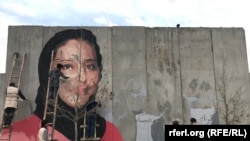A group of Afghan streets artists painted a mural to pay tribute to a prominent human rights defender who was killed by Hezb-e Islami, the former militant group that has since reconciled with the government.
But the mural in the capital, Kabul, did not last long. Only days after it was completed, masked men arrived to deface it. Initially thwarted by security guards, the culprits returned in the cover of darkness to finish the job.
No one has claimed responsibility for the act, but the artists did not have to look far in pointing blame. The mural was painted on a concrete blast wall in front of the American University of Afghanistan (AUAF) in western Kabul, located opposite the government-funded residence of Gulbuddin Hekmatyar, the notorious head of Hezb-e Islami.
In 2011, Hezb-e Islami claimed responsibility for the death of Hamida Barmaki, the prominent lawyer and human rights activist who was killed along with her entire family in a suicide bombing that year in Kabul.
The militant group signed a controversial peace deal with the government in 2016 in which Hekmatyar and his fighters were granted amnesty for past offenses and certain Hezb-e Islami members were freed from prison. The deal also includes provisions for his security and housing at government expense. The agreement was condemned by Western rights groups and many Afghans.
Hezb-e Islami has come under fire since the defacing of the mural on March 12, with activists making clear they believe the group is responsible, and condemning the vandalism as an attack on free speech.
ArtLords, a group of Kabul-based artists, painted the mural on a blast wall that is the property of the AUAF, which authorized the work.
On March 12, witnesses said four masked men descended from a four-wheel-drive vehicle with black-tinted windows and slabbed over the mural with white paint. They were dispersed by security guards at AUAF. The men appeared that same evening to finish the job.
On March 13, a group of activists gathered at the site to protest, laying flowers and plastering printouts of the original mural on the wall. But the activists were quickly dispersed by AUAF guards.
AUAF has given no explanation for their actions and could not be reached for comment.
Hezb-e Islami declined to comment on the issue.
The defacing of the wall has sparked anger at Hekmatyar, who is known as the "Butcher of Kabul" for shelling residential areas in the devastating civil war in the 1990s that destroyed most of the capital.
"Paint the mural again and again until it stands and stays there," Sayed Madadi, an Afghan activist, wrote on Twitter on March 12. [Hekmatyar] must feel that Kabul is different, learn that he's to be fine with art, media investigation, criticism, satire, and demonstration."
Shaharzad Akbar, an Afghan civil activist, also weighed in.
Amrullah Saleh, a former intelligence chief who heads the opposition Afghanistan Green Trend political party, tweeted that Hekmatyar might have reconciled with the government but he is "mentally and psychologically still at war."
Ramiz Bakhtiar, a founder of the PAYK Investigative Journalism Center, said on Twitter that it was "very important to remember war victims and demand justice even after a peace agreement is established."
Many also came out in support of ArtLords on social media. The group of artists have painted hundreds of murals across Kabul in their bid to bring about social change in the war-torn country. The group’s murals target corruption, injustice, and religious extremism.
The 68-year-old Hekmatyar, an Islamic fundamentalist, is one of the most controversial figures of the past three decades of war in Afghanistan.
Hekmatyar founded Hezb-e Islami in the mid-1970s to fight occupying Soviet troops and emerged after Moscow’s withdrawal as a leader of one of Afghanistan's more effective resistance forces. He and his militia then fought for control of Kabul in the civil war, during which his group’s infamous rocket attacks killed thousands of civilians.
Hezb-e Islami split up after the U.S.-led invasion in 2001, with the political wing reconciling with Kabul while Hekmatyar led an insurgency against Afghan and international security forces. A former U.S.-designated global terrorist, his militant group claimed responsibility for deadly bombings and suicide attacks across the country before reconciling with the government.





